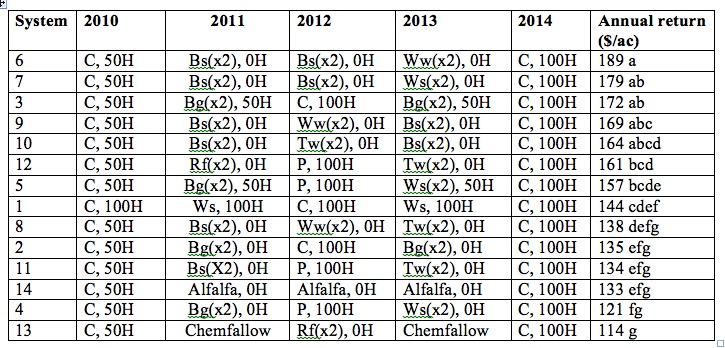
Diverse crop rotations return up to $45 per acre more
Diverse crop rotations had similar net returns to canola-wheat rotations one-half the time and up to $45 per acre more the rest of the time. Adding integrated weed management practices without relying on wild oat herbicides resulted in similar wild oat pressure as canola-wheat rotations. Eliminating wild oat herbicides is a tool to reduce herbicide-resistance selection pressure.
A five-year field study at eight sites across Canada evaluated the profitability of alternative cropping systems that have the potential to control wild oat using cultural practices in conjunction with herbicides and diverse crop rotations. Six of the sites were in western Canada at Edmonton, Lacombe, and Lethbridge, AB; Scott and Saskatoon, SK; and Carman, MB; and two were in eastern Canada (New Liskeard, ON; Normandin, QC).
In-crop wild oat herbicide (Group 1) was applied at 0%, 50%, or 100% of the recommended rate, depending on the cropping system treatments, and seeding rate was either the recommended rate or two times the recommended rate. Diverse crop rotations included field pea, barley for grain, barley silage, fall-seeded winter wheat or triticale, fallow, and alfalfa in the rotation. These crop rotations and IWM practices were compared to the common wheat-canola rotation at recommended seeding rate and wild oat herbicide rate.
To determine profitability, annualized net return for the last four years of the five-year trial were calculated. Annualized net return was determined using 2016 production costs. Commodity prices used a six-year average from 2009 to 2014. These were derived from Alberta Agriculture and Forestry, and Government of Saskatchewan data.
Many of the diversified cropping systems and IWM practices were at least as profitable or more profitable than the canola-wheat rotation. The most profitable crop rotation averaged over all sites was one with canola (50% herbicide) – barley silage (2x seeding and no herbicide) – winter wheat (2x seeding and no herbicide) – canola (100% herbicide). It produced an annualized net return of $189 per acre, significantly more than the canola-wheat rotation (100% herbicide) of $144 per acre.
At most locations, barley silage and either winter or spring wheat without herbicides to control wild oat had net returns similar to canola–wheat rotations with wild oat herbicide at 100%. However, for producers without livestock, lack of a close market to sell silage makes the barley silage rotations impractical.
Profitability varied by location
In western Canada, fall-seeded winter crops of rye, wheat, and triticale were more profitable crops at Lethbridge and could be recommended as rotational crops with canola. Fall-seeded winter crops in rotation at Lacombe, Scott, Saskatoon, and Carman generally had similar returns as other crops, but returns were inconsistent likely due to lower winter survival. At St. Albert, fall-seeded winter crops were less profitable than spring cropping options.
Average Annualized Net Returns ($/ac) over locations and four years (2011 – 2014) from highest to lowest

Note: C, canola; H, percent of recommended wild oat herbicide applied; WS, spring wheat; BG, barley grain; x2, seeding rate is twice the recommended rate; P, field pea; BS, early-cut barley silage; WW, winter wheat; TW, winter triticale; RF, fall rye.
Means within the annualized return column not sharing a lowercase letter differ significantly at the p < 0.05 level.
Source: Smith et al. 2018.
Annualized net return over four years with pea in rotation was among the more profitable systems at Edmonton, Lacombe, Carman, New Liskeard and Normandin.
Chemical fallow in the cropping system reduced net returns because of the lack of crop revenue during the year of fallow and was the least profitable rotational system.
Establishing alfalfa for 3 years of production was not as profitable as other crops in western Canada. However, canola returns in 2014 after alfalfa were generally high and the wild oat population was low.
Effect on wild oat management
The most effective control of wild oat included early-cut barley silage and winter cereals. Combining the double seeding rate for barley silage and winter cereals without wild oat herbicides in three of the five years often resulted in similar wild oat density, growth and seed bank populations as the wheat-canola rotation with herbicides. Three years of alfalfa without wild oat herbicides produced similar results.
However, eliminating wild oat herbicides in two of five years in the rotation with spring seeded annual crops resulted in higher wild oat density, biomass, and seed banks.
Overall, wild oat management and profitability varied by location but included an integrated system that reduced herbicide resistance selection pressure:
- Establishing a competitive crop through the use of higher seeding rates,
- Inclusion of winter cereals,
- Growing a pulse crop,
- Early silage harvest to prevent wild oat seed shed,
- No herbicides in barley silage and winter cereal rotations.
This work was possible due to funding from Agriculture and Agri-Food Canada, the Canola Cluster, the Western Grains Research Foundation Cluster, the Alberta Canola Producers Commission, Saskatchewan Canola, the Manitoba Canola Growers Association, and the Canola Council of Canada.
Smith, E.G, Harker, K.N., O’Donovan, J.T., Turkington, T.K., Blackshaw, R.E., Lupwayi, N.Z., Johnson, E.N., Pageau, D., Shirtliffe, S.J., Gulden, R.H., Hall, L.M. Christian J. Willenborg, D.J. The profitability of diverse crop rotations and other cultural methods that reduce wild oat. Can. J. Plant Sci. 98: 1–8 (2018)
https://doi.org/10.1139/cjps-2018-0019
Harker, K., O’Donovan, J., Turkington, T., Blackshaw, R., Lupwayi, N., Smith, E., Willenborg, C. (2016). Diverse Rotations and Optimal Cultural Practices Control Wild Oat (Avena fatua). Weed Science, 64(1), 170-180.
https://doi:10.1614/WS-D-15-00133.1


